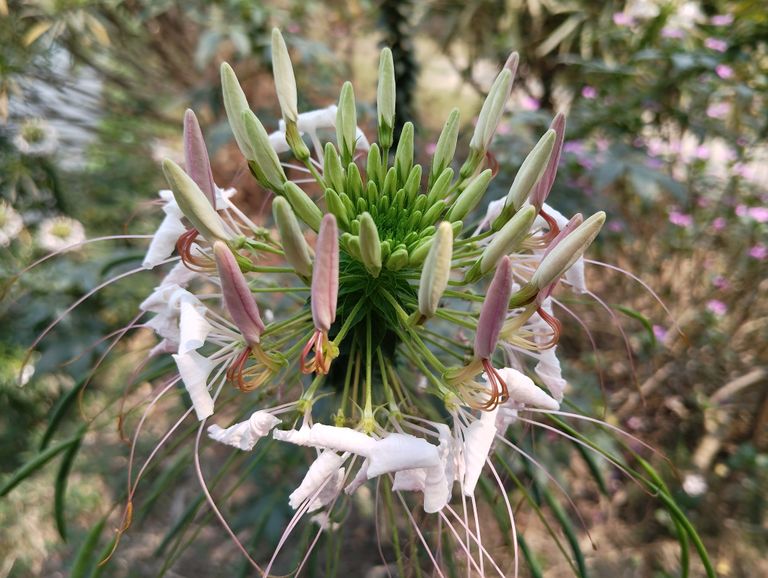
Mākrasa Hurhuri Flower The Enchanting Beauty of Nature.
Nature is filled with mesmerizing wonders, and one such fascinating bloom is the Mākrasa Hurhuri Flower. This flower, native to South Asia, particularly Bangladesh and India, is known for its delicate beauty, unique structure, and ecological significance. Despite its lesser-known status, it holds an important place in local biodiversity, traditional medicine, and cultural symbolism.
In this blog, we will explore the Mākrasa Hurhuri Flower, its characteristics, habitat, significance, and why it deserves more attention in botanical studies.
What is the Mākrasa Hurhuri Flower?
The name "Mākrasa Hurhuri" is derived from the Bengali language. "Mākrasa" means "spider," and "Hurhuri" refers to something feathery or fluffy. The flower is named so because of its thin, spindly petals that resemble the legs of a spider or soft, feathery structures.
It is a wildflower that blooms in tropical and subtropical climates, often found in rural fields, forests, and along riverbanks. The plant is usually small, with vibrant flowers that attract pollinators like bees, butterflies, and small birds.
Scientific Classification and Appearance
Although the exact scientific name of the Mākrasa Hurhuri Flower is debated, it is often linked to species from the Mimosa or Clematis families due to its feathery structure.
Physical Characteristics:
Petals: Thin, thread-like, often spreading outwards like a spider’s legs.
Color: Shades of pink, purple, or white.
Size: Small to medium-sized flowers, usually around 2-4 cm in diameter.
Leaves: Green, fern-like, sometimes sensitive to touch like the "Touch-Me-Not" plant.
Stem: Slender, sometimes creeping or climbing.
Where is the Mākrasa Hurhuri Flower Found?
The Mākrasa Hurhuri Flower thrives in warm, humid environments. It is commonly found in:
Bangladesh, India, Nepal, and Myanmar – in forests, village fields, and near water bodies.
Tropical and subtropical regions – where the climate is warm and monsoon rains help in its growth.
Roadside hedges, riverbanks, and open fields – where it grows naturally without much human intervention.
Due to deforestation and urban expansion, the habitat of this beautiful wildflower is shrinking, making conservation efforts more important.
Ecological Importance
Despite its small size, the Mākrasa Hurhuri Flower plays a vital role in the ecosystem:
- Attracting Pollinators – Bees, butterflies, and other insects are drawn to its nectar, which helps in plant pollination.
- Soil Health – It prevents soil erosion by growing in areas where the land is loose or disturbed.
- Biodiversity Support – Provides food and shelter for small insects and birds.
Traditional and Medicinal Uses
In rural areas, the Mākrasa Hurhuri Flower is sometimes used in traditional herbal remedies. Local healers and indigenous communities use it for:
Treating Skin Irritations – A paste made from the flower and leaves can help soothe rashes or insect bites.
Respiratory Relief – Some believe that its extracts help with cough and mild breathing issues.
Anti-inflammatory Properties – Used in poultices for swelling and pain relief.
Though traditional medicine has used this flower for centuries, more scientific studies are needed to validate its medicinal properties.
Cultural Significance
The Mākrasa Hurhuri Flower is not widely known in mainstream culture, but it holds value in folklore and rural traditions:
Symbol of Delicacy and Beauty – Its fragile, airy petals symbolize the fleeting beauty of nature.
Used in Rural Festivities – In some regions, children collect these flowers to decorate homes during local festivals.
Spiritual Symbolism – Some believe that seeing this flower in dreams is a sign of good luck and new beginnings.
Threats and Conservation
Like many wildflowers, the Mākrasa Hurhuri Flower is at risk due to:
- Deforestation – Rapid land clearing for agriculture and urbanization reduces its natural habitat.
- Climate Change – Unpredictable rainfall and temperature changes affect its growth cycle.
- Overgrazing – Cattle and livestock sometimes consume these plants, preventing them from flowering.
How Can We Help?
Preserving Wildflower Habitats – Protecting forests and natural landscapes ensures the survival of unique species.
Community Awareness – Educating people about the flower's importance can encourage conservation efforts.
Encouraging Botanical Studies – More research is needed to classify and document the flower scientifically.
Final Thoughts
The Mākrasa Hurhuri Flower is a hidden gem of nature, often overlooked yet valuable in many ways. Its delicate appearance, ecological role, and cultural significance make it a plant worth appreciating and protecting.
While it may not be as famous as roses or orchids, its beauty and role in the environment remind us that even the smallest flowers have a big impact on the world around us.
By raising awareness and encouraging conservation efforts, we can ensure that this enchanting flower continues to bloom for generations to come.
Have you ever seen the Mākrasa Hurhuri Flower? Share your thoughts or experiences in the comments! Let’s celebrate the beauty of wildflowers together.
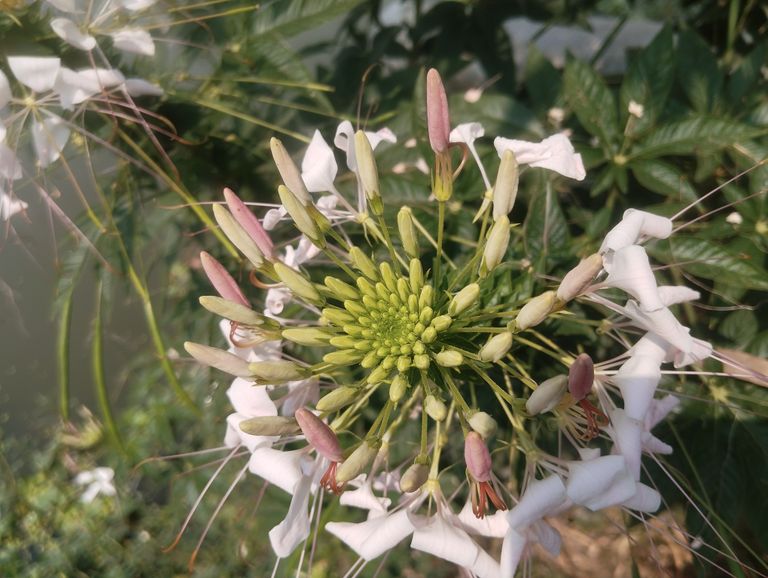
The Enchanting Beauty of the Makorsha Hurhuri Flower
Nature has blessed us with countless breathtaking flowers, each with its own unique charm. Among them, the Makorsha Hurhuri flower stands out with its delicate, feathery appearance and mesmerizing beauty. Though not as widely known as roses or orchids, this flower captivates nature lovers with its soft, intricate petals and gentle sway in the wind.
In this blog, we will explore the appearance, habitat, significance, and cultural relevance of the Makorsha Hurhuri flower, unveiling the secrets of this lesser-known botanical wonder.
- A Unique Floral Marvel: The Appearance of Makorsha Hurhuri
The Makorsha Hurhuri flower is often admired for its light, feathery petals, which resemble the silk threads of a spider’s web—hence its name, as "Makorsha" means "spider" in Bengali. The flowers usually bloom in clusters, creating a dreamy, cotton-like visual effect.
Color Palette: The flower comes in shades of soft white, pale pink, and light purple, giving it a delicate charm.
Petals & Texture: Its thin, thread-like petals give it an airy, almost floating appearance, making it stand out in any natural landscape.
Fragrance: Unlike many vividly colored flowers, the Makorsha Hurhuri has a mild yet refreshing fragrance, attracting butterflies and bees.
This fascinating structure makes the flower a natural spectacle, drawing admiration from botanists and nature enthusiasts alike.
- Natural Habitat: Where Does It Grow?
The Makorsha Hurhuri flower is commonly found in moist, tropical, and subtropical regions, thriving in areas with rich soil and moderate sunlight.
Native Regions: This flower is predominantly found in South Asia, particularly in Bangladesh and India.
Growth Conditions: It prefers humid weather, well-drained soil, and partial sunlight, making it a common sight in gardens, forests, and riverbanks.
Seasonal Blooming: It flourishes during the monsoon and post-monsoon seasons, when the weather is damp and ideal for its growth.
Due to its love for humidity, it often grows in wild meadows, beside lakes, or in shaded garden corners, adding an ethereal beauty to its surroundings.
- Cultural & Medicinal Significance
A Symbol of Delicate Beauty
In Bengali culture, flowers play an essential role in poetry, songs, and traditional ceremonies. The Makorsha Hurhuri, with its soft, floating petals, is often associated with gentleness, fragility, and fleeting beauty. It symbolizes purity and peace, making it a favorite for floral decorations.
Traditional Medicinal Uses
Beyond its aesthetic appeal, this flower is believed to have medicinal properties in folk traditions:
Herbal Remedies: Some traditional healers use it to treat skin irritations and minor wounds due to its soothing nature.
Aromatherapy: The light fragrance is thought to help in reducing stress and anxiety, making it a popular ingredient in herbal teas and essential oils.
Natural Cooling Agent: The petals are sometimes crushed and used in cooling pastes for summer ailments.
Although not widely studied in modern medicine, these folk remedies highlight the flower’s potential health benefits.
- The Role of Makorsha Hurhuri in Biodiversity
This delicate flower is not just a treat for human admirers—it plays a vital role in maintaining ecological balance.
Pollinator Attraction: The flower’s soft fragrance and nectar attract bees, butterflies, and hummingbirds, contributing to pollination and biodiversity.
Soil Health: Its presence in wild areas prevents soil erosion by holding the earth together with its roots.
Eco-Friendly Ornamental Plant: Many gardeners prefer planting it as a natural air purifier and soil conditioner in home gardens.
Given its ecological significance, conservation efforts should be encouraged to preserve this beautiful species.
- How to Grow Makorsha Hurhuri in Your Garden?
If you are mesmerized by this flower’s beauty, you’ll be delighted to know that it is relatively easy to grow. Here are some gardening tips:
Step 1: Choose the Right Spot
Select a location with partial sunlight and moist, well-drained soil.
If you live in a dry climate, consider watering the plant regularly.
Step 2: Soil Preparation
Mix organic compost into the soil for better growth.
Ensure the soil remains loose and well-aerated.
Step 3: Planting & Care
Sow seeds or plant saplings during the early monsoon season.
Water the plant moderately, as excessive water can lead to root rot.
Prune occasionally to maintain healthy growth and prevent overgrowth.
By following these simple steps, you can enjoy the enchanting beauty of Makorsha Hurhuri flowers in your home garden.
- Conclusion: A Hidden Treasure of Nature
The Makorsha Hurhuri flower may not be as famous as roses or lilies, but its graceful, floating beauty makes it a hidden gem in the world of flora. Whether admired in the wild, used in traditional medicine, or cultivated in home gardens, this flower is a symbol of nature’s delicate artistry.
As we continue to appreciate the wonders of nature, let us also strive to preserve and nurture these beautiful blooms for future generations. If you ever come across a field of Makorsha Hurhuri swaying gently in the breeze, take a moment to admire its simple yet profound elegance.
Did you enjoy learning about this enchanting flower?
Share your thoughts or experiences with the Makorsha Hurhuri in the comments! If you love nature, consider planting one in your garden and witnessing its magic up close.
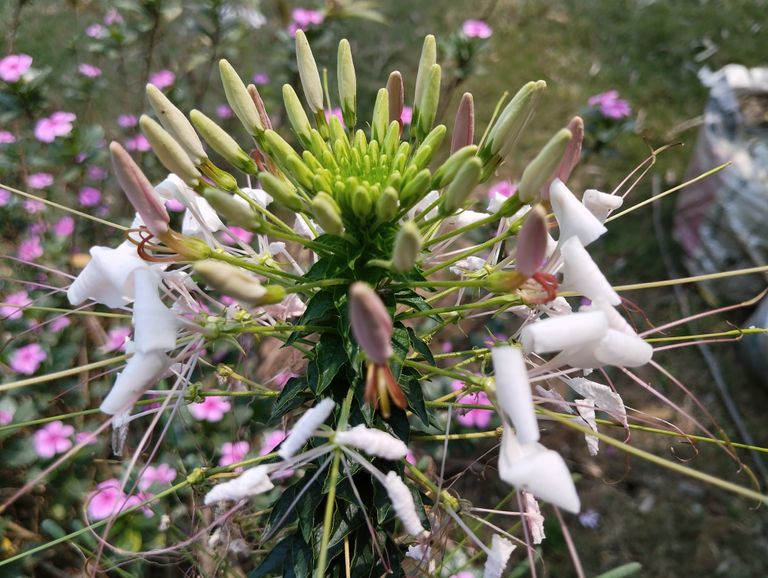
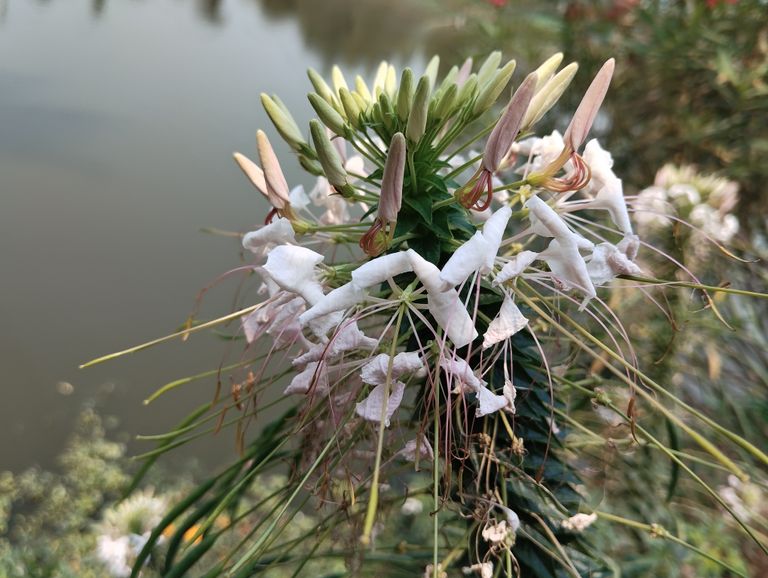
Capturing the Beauty of Hurhuri Flowers: A Complete Photography Guide
Flowers have always been a favorite subject for photographers due to their vibrant colors, intricate patterns, and natural beauty. Among them, the Hurhuri flower (also known as Blumea lacera) is an incredibly unique species that blooms in various regions, particularly in South Asia. This delicate wildflower has an airy, feathery appearance, making it an excellent subject for macro and nature photography.
In this blog, we will explore the best techniques, equipment, and settings for photographing Hurhuri flowers and capturing their true essence.
- Understanding the Hurhuri Flower
Before diving into photography techniques, it’s important to understand the subject. The Hurhuri flower is a small, yellowish, or whitish wildflower often found in grasslands, open fields, and alongside roads. Its delicate, fluffy seeds resemble dandelions and disperse with the wind, creating a mesmerizing visual effect.
These flowers thrive in moist conditions and bloom primarily in spring and autumn. They are tiny, requiring close-up or macro photography techniques to capture their intricate details.
- Essential Gear for Photographing Hurhuri Flowers
To get the best shots of these delicate blooms, consider using the following photography equipment:
a) Camera Options
DSLR or Mirrorless Camera: A high-resolution camera (such as a Canon EOS R5, Nikon Z7, or Sony A7R IV) is ideal for detailed macro shots.
Smartphones with Macro Lenses: If you don’t have a professional camera, flagship smartphones like the iPhone 15 Pro or Samsung Galaxy S24 Ultra with a macro mode can work well.
b) Lenses for Flower Photography
Macro Lens (90mm or 100mm): A dedicated macro lens will help capture sharp details of the Hurhuri flower.
Prime Lens (50mm or 85mm): These lenses provide beautiful depth of field and background blur (bokeh).
Telephoto Lens (70-200mm): Useful for taking flower shots from a distance while maintaining a soft, blurred background.
c) Additional Accessories
Tripod: A sturdy tripod minimizes camera shake, especially for close-up shots.
Reflector or Diffuser: Helps control natural light and shadows.
Remote Shutter Release: Prevents camera shake while taking macro shots.
- Best Camera Settings for Hurhuri Flower Photography
Setting up your camera correctly is key to capturing clear and vibrant images. Here are the optimal settings:
Aperture (f/2.8 – f/5.6): A wider aperture creates a dreamy background blur while keeping the flower in sharp focus.
Shutter Speed (1/200s – 1/1000s): A fast shutter speed prevents blur caused by wind movement.
ISO (100 – 400): Keeping ISO low ensures minimal noise and maximum clarity.
Focus Mode (Manual or Autofocus with Focus Peaking): Helps in locking focus on the flower’s intricate details.
White Balance (Daylight or Cloudy Mode): Enhances natural colors.
For smartphone photography, use pro mode (if available) and adjust focus manually to get sharp images.
- Lighting Techniques for Capturing Hurhuri Flowers
a) Natural Light Photography
Golden Hour (Early Morning & Late Afternoon): Soft, warm light enhances flower textures and colors.
Overcast Days: Clouds act as a natural diffuser, reducing harsh shadows.
Backlighting: Position the flower against the sun to create a glowing effect.
b) Artificial Light Photography
Ring Light or LED Panel: Helps illuminate the flower in low-light conditions.
External Flash with Diffuser: Softens harsh light for a more natural look.
- Composition Tips for Stunning Flower Photography
Use the Rule of Thirds: Place the Hurhuri flower off-center to create an aesthetically pleasing composition.
Experiment with Angles: Capture flowers from different perspectives – top-down, side, or even from below.
Include the Environment: Show surrounding elements like grass, leaves, or insects to add context.
Try Close-Ups & Macro Shots: Highlight the delicate textures and intricate details of the flower.
Utilize Negative Space: A blurred background helps make the flower stand out.
- Post-Processing for Enhancing Flower Photography
Editing plays a crucial role in making your photos stand out. Use the following tools:
Adobe Lightroom: Adjust exposure, contrast, and colors for a balanced look.
Photoshop: Enhance details and remove unwanted distractions.
Snapseed (For Mobile Users): Great for quick touch-ups and adjustments.
Focus Stacking: Combine multiple images to ensure the entire flower is in sharp focus.
- Creative Ideas for Hurhuri Flower Photography
Dew Drops & Water Sprays: Spraying water on the petals creates a fresh, dewy look.
Slow Motion or Time-Lapse: Capture the dispersing seeds in action.
Silhouettes at Sunset: Use backlighting to create artistic silhouettes of the flower.
Bokeh Backgrounds: Experiment with fairy lights or blurred nature backgrounds for dreamy aesthetics.
Monochrome Edits: Convert images to black and white for a unique artistic touch.
- Challenges & Solutions in Flower Photography
a) Wind Movement
Use higher shutter speeds (1/500s or more) to freeze motion.
Shield the flower with your body or use a wind blocker.
b) Harsh Shadows
Shoot on cloudy days or use a diffuser to soften shadows.
c) Inconsistent Focus
Use manual focus for better control over sharpness.
Utilize focus stacking for detailed macro shots.
- Sharing & Showcasing Your Flower Photography
Once you have captured stunning images of Hurhuri flowers, consider sharing them on:
Instagram & Pinterest: Use hashtags like #MacroPhotography, #FlowerMagic, or #NatureLover.
Photography Forums: Engage with communities like 500px, Flickr, or Reddit’s r/photography.
Print & Frame: Create wall art with your best shots.
Online Portfolio: Showcase your work on a personal website or Behance.
Conclusion
Photographing Hurhuri flowers is a rewarding experience that allows you to appreciate nature’s delicate beauty. With the right gear, settings, lighting, and composition techniques, you can create breathtaking images that highlight the intricate details of these wildflowers.
Whether you’re using a DSLR, mirrorless camera, or smartphone, practicing different angles and lighting conditions will help refine your skills. Don’t forget to experiment, be patient, and enjoy the process of capturing these tiny marvels. Have you photographed Hurhuri flowers before? Share your best shots and experiences in the comments below.
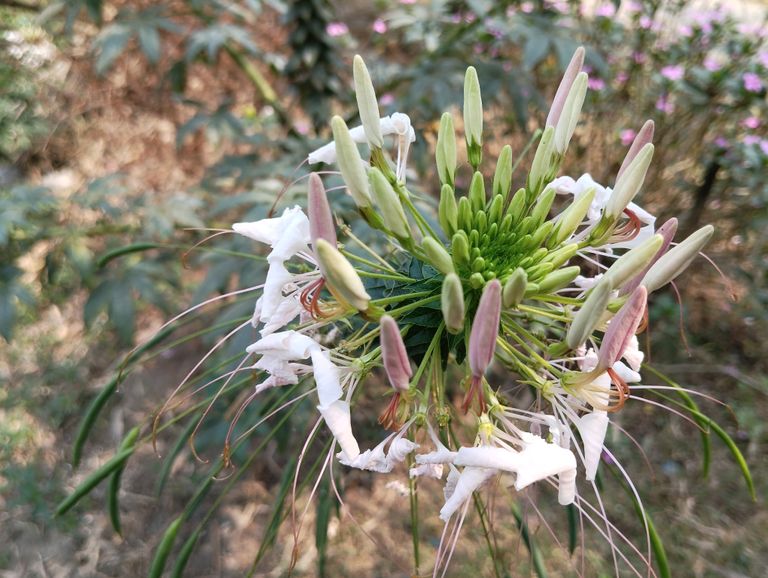
Congratulations, your post has been upvoted by @dsc-r2cornell, which is the curating account for @R2cornell's Discord Community.
Enhorabuena, su "post" ha sido "up-voted" por @dsc-r2cornell, que es la "cuenta curating" de la Comunidad de la Discordia de @R2cornell.